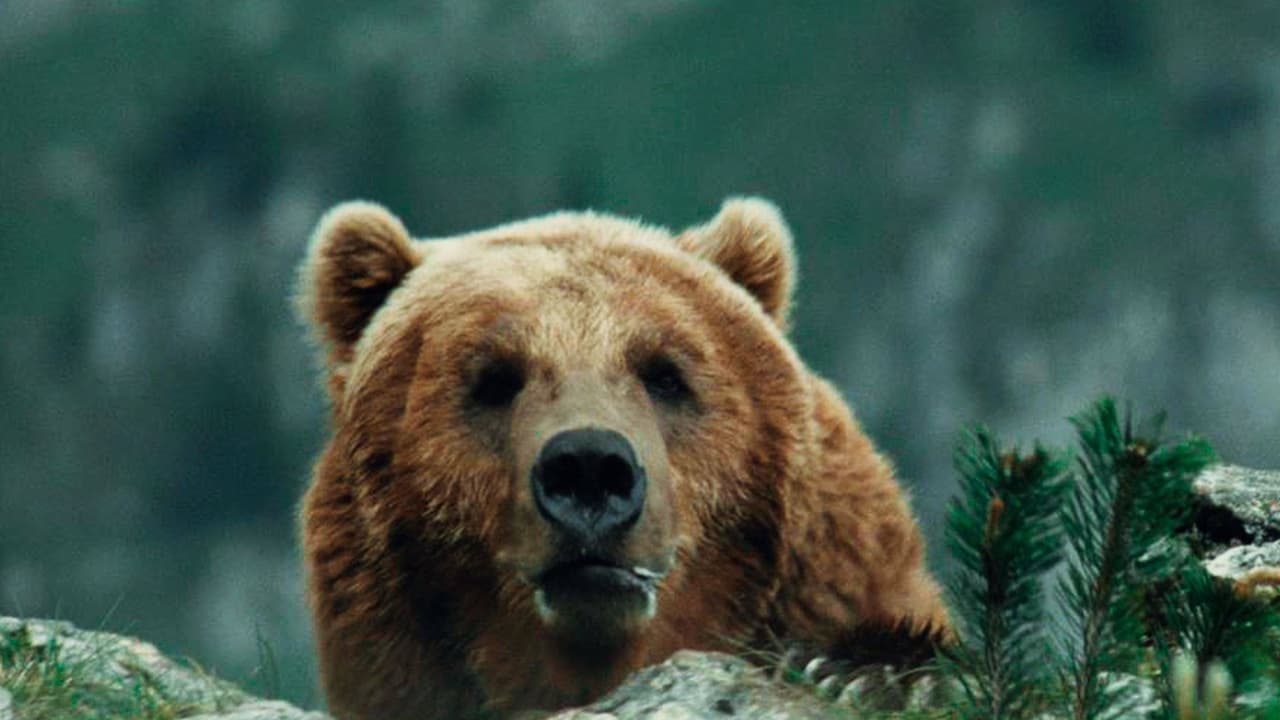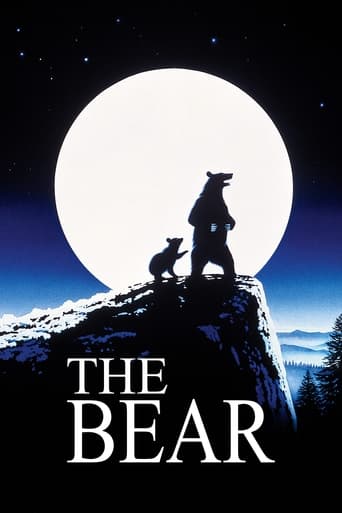

People are voting emotionally.
... View MoreThe performances transcend the film's tropes, grounding it in characters that feel more complete than this subgenre often produces.
... View MoreI cannot think of one single thing that I would change about this film. The acting is incomparable, the directing deft, and the writing poignantly brilliant.
... View MoreStrong acting helps the film overcome an uncertain premise and create characters that hold our attention absolutely.
... View MoreMan Bites Bear It's easy to see why this film was rated so highly. It's awfully likable. The principles are Youk, a bear cub, and Bart, a 1500 pound fully grown male Kodiak bear. Poor Youk. His mother is digging out a honeycomb and dislodges a large chunk of granite which crushes her head. Youk, whimpering, must take off on his own, wobbling along through the grasslands and crags of the Wasatch Mountains in Utah, an inhospitable place to everyone but skiers.We are then introduced to the mammoth Bart, who shoos off the rugrat, clearly a bear with dependency issues. Still the cub follows Bart around, though unwanted. Then, enter the enemy, two sinister hunters collecting bear skins to sell for the manufacture of robes, rugs, coats, hats, and whatever else they make out of bearskins. Pow! And Bart is wounded in the shoulder, wobbling off painfully until he manages to heal his wound by rolling around in a muddy pond. His convalescence over, Bart adopts Youk, and teaches him the rules of the game.But during his escape from the two hunters, Bart has killed one of their horses and wounded the other, so now revenge joins profit in motivating the two hunters, who bring in a pack of hunting hounds. Well, I'll tell you, it's one tribulation after another, both for the bears and for the hunters. Youk is hunted by the angriest mountain lion known to man or beast and is saved at the last minute by the intervention of Big Bart. Big Bart also traps the meanest of the hunters, scares the crap out of him, and then after roaring, bearing his teeth, and scraping some dust on the cowering human ("Please, don't kill me!") he wanders off, satisfied that he's made his message clear through his body language and prosody. And he HAS too. The mean hunter has an epiphany. Later when he has a clear opportunity to kill Bart, he spares him.What makes the film so appealing, chiefly, are two of its features.First, Youk is both ugly and cute at the same time. He's pretty funny too, rolling around, eating psychedelic mushrooms and tripping out, so that a floating mushroom turns into a real butterfly. The hunters manage to capture him and in their absence from the camp he rummages through their possessions and winds up covered with feathers. Cute. He witnesses a primal scene involving Bart and a sluttish female and falls asleep while they copulate.Second, although we are constantly on the side of the bears, the humans are not shown as resolutely evil in their actions or their emotions. Having captured Youk, they tie him to a tree, tease him, and laugh at his antics. He's not treated badly. When the men ride away, Youk is perfectly willing to follow them so they must scare him away. And the humans don't show any animus towards bears or other animals. They like their dogs and their horses. They're just depicted as making a living. The living involves killing animals, but the bears kill deer too. Everybody has to make a living.The framework for the relationship between humans and their natural environments was described by an anthropologist, Florence Kluckhohn, who observed that people had three ways of dealing with nature: they could live in submission to it, they could live in harmony with it, or they could try to conquer it. The hunters in this film are more or less living in harmony with nature. The iconography suggests this story takes place in the late 19th century. By that time -- up to and including now -- not everyone felt that way. We have no more passenger pigeons in North America, though they used to darken the skies. If you want to see an American buffalo, you must go to a zoo now. Wolves are disappearing and grizzlies are increasingly hard to come by. I won't go on about this point, though it would be easy to do.One annoying element of the film is that, well, I'm afraid some of Youk's whimpers, screams, and inquiries were dubbed by either a pre-adolescent human child or a fully blown human woman. We can clearly hear little Youk uttering, "Huh?" and "Wow" and "Oh" and "Wassup" and "So's your old man" and reciting Hamlet's famous soliloquy -- "To be or not to be". Under the influence of those psychedelic mushrooms he fantasizes himself at the Metropolitan opera singing "La Donna e Mobile" to a packed house.I kind of enjoyed it, despite the cuteness, not because of it.
... View MoreI tend to be a genuine sucker for animal pictures. One of the reasons may be because animals are so genuinely unpredictable, unlike most people in the movies these days. You can look into the eyes of most animals and not have a real clear picture of what they are thinking or feeling. So I sometimes find movie-animals more fascinating than movie-people. But the second—and primary—reason is because they bring me to admire the skills and patience that go into making a film. All movies are difficult to make, even the awful ones. That goes without saying. But there a number of them where the tremendous effort does not really paint itself on the screen, regardless of whether they are good or bad, absorbing or unbearable. I tend to be astonishing by animal movies for the same reason I tend to be astonished by movies featuring stop-motion animation: I instantly become aware of the exhaustion the creators had to subject themselves to.To make "The Bear," the filmmakers required their stars, two bears, one an adult, the other a cub, to crawl across landscapes, play around in water, and appear to grow close to one another. The cub is orphaned at the beginning of the picture when its mother is killed in a landslide; the adult is a territorial old male wounded by bear hunters. Now the bears had to perform just right before the camera. They had to not only appear convincing, but maintain continuity whenever the director would decide it was time to move the camera to another angle. I've heard of accounts where the director and trainer would wait all day just to get the bear cub to turn its head in the right direction for a subsequent shot and then keep its head there when they got to that subsequent shot.On that level, and others, "The Bear" is an absorbing movie-going experience. But it is also a glorious massage on the senses. First of all, it looks beautiful. The directing, which consists of numerous cuts, not just long documentary extreme wide-angles, is consistently interesting. Also remarkable is the sound design. The movie was probably shot, mostly, without any sound equipment, for the trainers would be shouting at the bears every second, commanding them what to do and when. So every footstep, every grunt, snarl, bird chirp, gust of wind, sound of a grasshopper, you name it, was developed and integrated in post-production. Yet it all feels so natural; it was not until after I saw the movie that I became aware of this, once again reminding me of how much stress the filmmakers had to put upon themselves.Just imaging the making of "The Bear" puts my memories of volunteering on "The Boarder," a low-budget family drama shot in rural Nebraska, to shame.I also liked the movie for its human scenes. I guess that contradicts part of my opening statement, but then again, there seems to be an exception to every rule when it comes to the movies. The only humans in the movies are the two hunters chasing after the adult bear. Apart from the wonderful acting by Jack Wallace and Tcheky Karyo, I also enjoyed the level of detail given to them. The way, in the opening, the movie breaks down the process by which they hunt the bear. I particularly liked the touch where Mr. Wallace plucks some grass and lets it fly from his fingertips in the wind, so he knows just how much he needs to angle his rifle before he takes the shot. These are pretty interesting characters, and I actually did not mind it so much when their moral denouement at the end flew completely from the realm of predictability."The Bear" only loses its head when it tries to get inside the mind of a bear. Literally. Animals dream. Anybody who has ever owned a dog knows that. But just what they dream or what they see in their dreams is anybody's guess. Now the movie does offer a suggestion: a purple-tinted world with a quirkier-moving version of the animal wandering about in some strange surrounding. The dream sequences are handled through stop-motion animation: the other movie-making process that astounds me. And also I certainly did not mind seeing the animation, it nevertheless broke the shape of the picture. More effective would have been implying that the animal was dreaming and allowing us to use our imagination.
... View MoreI wish they have left some things out. The stupid noises of the little bear, the dreams, the bad acting of the men, etc. Ignoring that, the rest was really OK. They must have had a lot of patience, waiting for the animals to do the right thing at the right moment. Stil it looked quite natural. Except for the stupid noises of course.Timing the hole thing seems to be something else. When the 2 bears meet, the old bear has some serious wounds. At a certain moment, they are healed. But I would except the little bear to have grown more during the healing period of the old bear.I do think it was filmed in the Italian dolomiti. I definitely recognized the Tofana di Rozes near Cortina d'Ampezzo. Very nice film for all ages!
... View MoreWell-received French film from James Oliver Curwood's book harks back to the wildlife documentaries from 1950s Disney in both style and sentiment, as an orphaned bear cub trails a Kodiak bear around a mountain terrain for companionship. Soon, they're both being followed by an eager pack of hunters. "The Bear" features several eloquent and lovely moments, captured beautifully on film by director Jean-Jacques Annaud, though unfortunately the film as a whole isn't especially worthwhile. The animals are manipulated into action for the sake of thrills, some of which have a brutal edge, leaving an uncomfortable pall hanging over the project. Ultimately, it's an old-fashioned adventure story with a sincere appreciation for the bears involved, yet it doesn't leave one feeling very satisfied. ** from ****
... View More